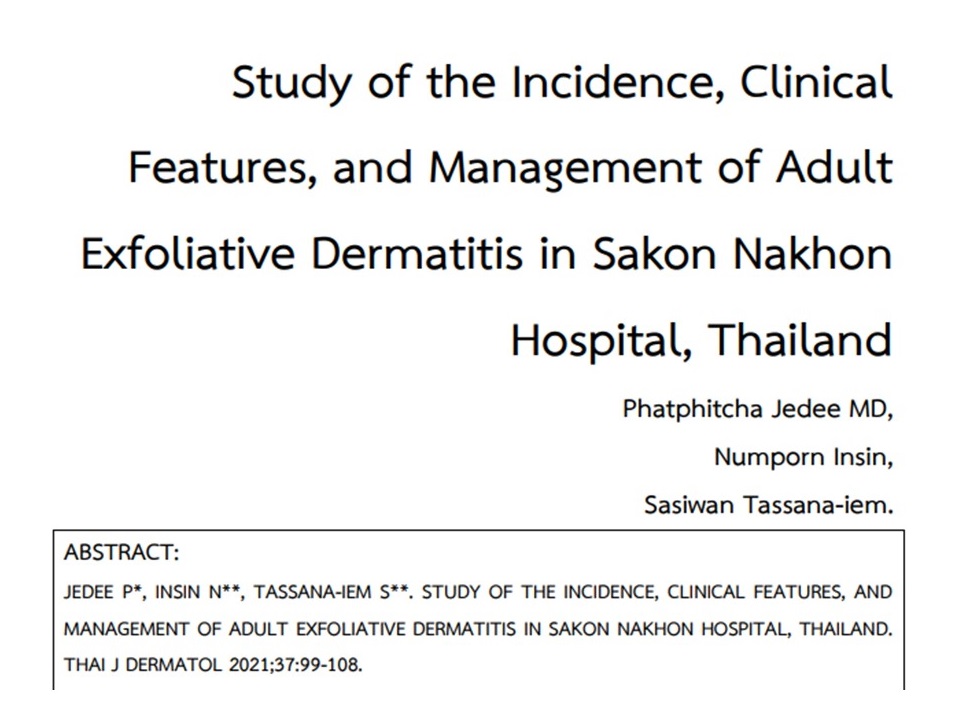Study of the Incidence, Clinical Features, and Management of Adult Exfoliative Dermatitis in Sakon Nakhon Hospital, Thailand
Keywords:
Exfoliative dermatitis, incidence, clinical features, management, outcomeAbstract
Background: Exfoliative dermatitis is the clinical finding of generalized erythema and scaling of the skin affecting more than 90% of the total body surface area. Prospective studies of exfoliative dermatitis are few in the literature. The aim of this study was to analyze the incidence, clinical features, and management of exfoliative dermatitis patients.
Materials and Methods: This prospective study was performed at Sakon Nakhon Hospital, Thailand, and included 32 patients who were diagnosed with exfoliative dermatitis in January-December 2019. Then the patients were followed up for 12 months. The incidence, clinical features, laboratory investigations, treatments, and outcomes were collected.
Results: Hospital incidence in 1 year of exfoliative dermatitis was 160 cases/100,000 dermatological outpatients or 32 cases/year. The mean age was 50 years old. Psoriasis was the most frequent etiology of exfoliative dermatitis. All patients had pruritus and erythematous plaques with scales. Other common clinical features were nail alterations and fever. Abnormal laboratory investigations were anemia, leukocytosis, eosinophilia, and high erythrocyte sedimentation rate. Combinations of systemic drugs (systemic steroids, methotrexate, cyclosporine, acitretin) and topical drugs were the main treatments. The comparison between psoriasis and eczema groups in exfoliative dermatitis showed that the eczema group had higher ages, higher eosinophilia, lower serum total protein, shorter durations of treatments, lower percentages of last body surface area, and higher numbers of complete clearance patients than the psoriasis group.
Conclusion: This study had high hospital incidence of exfoliative dermatitis in Thailand. Exfoliative dermatitis usually presented generalized scaly erythema of the skin. Multiple skin disorders could cause exfoliative dermatitis. Complete physical examinations and investigations should be performed in each patient.
References
Sigurdsson V, Steegmans PH, van Vloten WA. The incidence of erythroderma: a survey among all dermatologists in the Netherlands. J Am Acad Dermatol 2001;45:675-8.
Hasan T, Jansén CT: Erythroderma: a follow-up of fifty cases. J Am Acad Dermatol 1983;8:836-40.
Leenutaphong V, Kulthanan K, Pohboon C, Suthipinittharn P, Sivayathorn A, Sunthonpalin P. Erythroderma in Thai patients. J Med Assoc Thai 1999;82:743-8.
Sakuntaphai A. Exfoliative dermatitis: a report of 28 cases. Thai J Dermatol 1987;3:71-5.
Miyashiro D, Sanches JA. Erythroderma: a prospective study of 309 patients followed for 12 years in a tertiary center. Sci Rep 2020;10:9774.
Sehgal VN, Srivastava G. Exfoliative dermatitis: A prospective study of 80 patients. Dermatologica 1986;173:278-84.
Cuellar-Barboza A, Ocampo-Candiani J, Herz-Ruelas ME. A Practical Approach to the Diagnosis and Treatment of Adult Erythroderma. Actas Dermosifiliogr 2018;109:777-90.
Banerjee S, Ghosh S, Mandal RK. A Study of Correlation Between Clinical and Histopathological Findings of Erythroderma in North Bengal Population. Indian J Dermatol 2015;60:549-55.
Salami TA, Enahoro Oziegbe O, Omeife H. Exfoliative dermatitis: patterns of clinical presentation in a tropical rural and suburban dermatology practice in Nigeria. Int J Dermatol 2012;51:1086-9.
Khaled A, Sellami A, Fazaa B, Kharfi M, Zeglaoui F, Kamoun MR. Acquired erythroderma in adults: a clinical and prognostic study. J Eur Acad Dermatol Venereol 2010;24:781-8.
Sigurdsson V, Toonstra J, Hezemans-Boer M, van Vloten WA. Erythroderma. A clinical and follow-up study of 102 patients, with special emphasis on survival. J Am Acad Dermatol 1996;35:53-7.
Kondo RN, Gon ADS, Minelli L, Mendes M, Pontello R. Exfoliative dermatitis: clinical and etiologic study of 58 cases. An Bras Dermatol 2006;81:233-7.
Li J, Zheng HY. Erythroderma: a clinical and prognostic study. Dermatology 2012;225:154-62.
Rothe MJ, Bernstein ML, Grant-Kels JM. Life-threatening erythroderma: diagnosing and treating the "red man". Clin Dermatol 2005;23:206-17.
César A, Cruz M, Mota A, Azevedo F. Erythroderma. A clinical and etiological study of 103 patients. J Dermatol Case Rep 2016;10:1-9.
Long H, Zhang G, Wang L, Lu Q. Eosinophilic Skin Diseases: A Comprehensive Review. Clin Rev Allergy Immunol 2016;50:189-213.

Downloads
Published
How to Cite
Issue
Section
License
เนื้อหาและข้อมูลในบทความที่ลงตีพิมพ์ในวารสารโรคผิวหนัง ถือเป็นข้อคิดเห็นและความรับผิดชอบของผู้เขียนบทความโดยตรงซึ่งกองบรรณาธิการวารสาร ไม่จำเป็นต้องเห็นด้วย หรือร่วมรับผิดชอบใดๆ
บทความ ข้อมูล เนื้อหา รูปภาพ ฯลฯ ที่ได้รับการตีพิมพ์ในวารสารโรคผิวหนัง ถือเป็นลิขสิทธิ์ของวารสารฯ หากบุคคลหรือหน่วยงานใดต้องการนำทั้งหมดหรือส่วนหนึ่งส่วนใดไปเผยแพร่ต่อหรือเพื่อกระทำการใดๆ จะต้องได้รับอนุญาตเป็นลายลักอักษรจากบรรณาธิการวารสารโรคผิวหนังก่อนเท่านั้น


